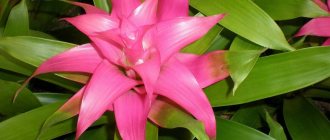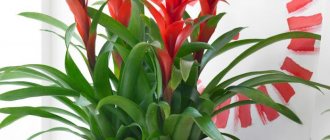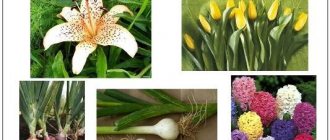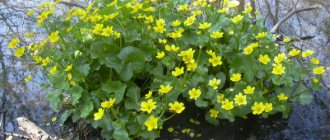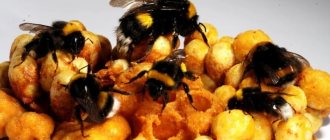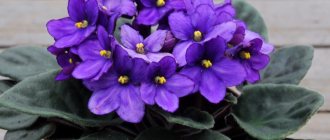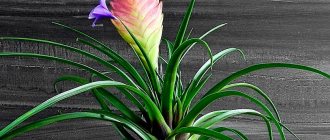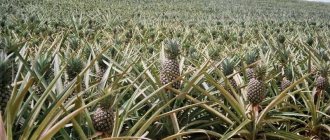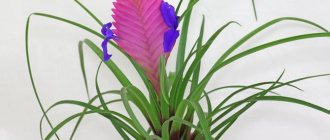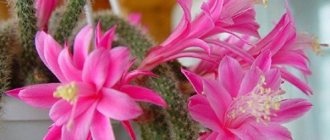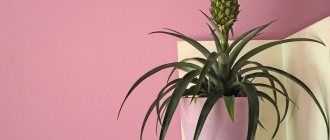Family Bromeliads
Plants in the Bromeliad family originate from the tropics, and several species have been found in the American subtropics and one in western Africa.
Bromeliads are epiphytes, meaning they grow on trees, rocks or other plants and obtain water and nutrients from the air and rainwater. Unlike most plants, they do not receive the necessary substances from the root system. Their roots are just a way to join the growing support.
Bromeliad
Almost all members of the Bromeliad family are characterized by the presence of a short stem and long urea-shaped leaves that are attached to each other and form a funnel. The structure of the leaves is simple: in some representatives of the species they are wide and dense, in others they are thin with a loose structure. Depending on the species, the inflorescence can be capitate, racemose or paniculate.
Types and characteristics of indoor plants from the Bromeliad family
There are about 3,000 different types of these flowers, among them: cryptanthus, guzmania, vriesia, indoor pineapple, aechmea, neoregelia, billbergia, acanthostachis, neoregelia, nidularium and many others.
Note! Those who have heard the name Bromeliad de Zapata and want to buy this flower need to know that it does not exist, it is an April Fool's joke.
Penguin
If you look at a photo of a bromeliad plant of this species, you will notice that it has a multi-flowered paniculate inflorescence. Its branches are always narrow pyramidal, consisting of 12 flowers with a slight powdery coating. The bracts grow no more than 3 cm long, and the flowers themselves on pedicels reach approximately 6 cm. The sepals are arranged freely, they have the shape of a triangle from one and a half to three centimeters long. The usual color for them is pink, with a small white border around the edges and at the base. After the flowers fall, small fruits appear. They are edible, but very sour in taste.
How to care for these plants at home
Bromeliad - home care, watering and propagation
Almost all bromeliads are adapted to warm, humid, shady climates. Their original habitat is moist and they grow under the shade of trees or are attached to them.
Important! Bromeliads do not tolerate exposure to large amounts of direct sunlight.
Temperature, humidity, light
The optimal temperature for bromeliads is considered to be in the range of 15-26 ºС, but they can survive in very hot climates.
Bromeliad indoor plants require 60% air humidity. This level is difficult to maintain, especially in winter when the house is heated.
Ways to humidify the air:
- place a humidifier near the plant;
- place a tray with moisture, for example, place pebbles and decorative elements in a deep large bowl and fill with water;
- move several plants closer to the bromeliad, due to the process of transpiration, the humidity next to it will increase;
- Regularly spray the flower from a bottle with an aerosol tube.
Light
Not all varieties of bromeliads prefer bright, indirect light; some grow better in constant shade. In winter, they need to be moved to a south-facing window.
Optimal soil for Bromeliads
For these representatives of the fauna, loose soil is suitable, which mainly consists of high-moor peat with the addition of leaf soil and sand. The soil for Bromeliads is diluted with bark, coal, coniferous soil, and chopped sphagnum.
Reproduction
To obtain a new plant, bromeliads can be propagated at home. You can do this in two ways:
- By shoots. As soon as the plant fades, new shoots - shoots - appear at the base of the rosette. They are left untouched for 2–3 months and waited for them to get stronger. And then they cut it with a sharp knife, and sprinkle the cut area with charcoal. A mixture of peat and sand is poured into the container, and the shoots are planted. Cover the top with film. Periodically moisten and ventilate. After new leaves appear, the greenhouse is removed. Rooting occurs within 1–2 months. After a year, the plant is transplanted into new soil. The first flowering can be expected after two years.
- Seeds. A complex and ineffective method. Seed material is purchased at the store. Sow seeds only in pre-disinfected soil. The container is filled with a substrate of leaf soil, sphagnum and sand. Seeds are placed on top. Keep in partial shade and regularly moisten the soil. The first shoots appear after 3–4 weeks. Their picking is carried out after the appearance of three leaves. They are transplanted to a permanent place after 2–3 months. Flowering occurs after 5–10 years.
Bromeliads are easy to propagate at home; the main thing is to choose the right method.
Tillandsia - a plant without roots
Hatiora - home care: air humidity and other requirements
Tillandsia aerial or atmospheric is an exotic plant of the Bromeliad family. The most popular representative of the genus, requiring difficult care.
Tillandsia
The main way to obtain moisture from Tillandsia without roots is through the leaves, which need to be sprayed regularly. To grow this flower, it needs to be provided with a cozy atmosphere with diffused lighting (about 14-15 hours a day), without drafts, and with clean fresh air. The optimal temperature for this representative of Bromeliads is 20-25 ºС.
How to replant
Tillandsia rootless requires replanting only once after purchasing it in the store. When the plant fades, it dies, so it does not need to change the soil.
Variety of species
There are about 500 species of this representative, including: Tillandsia Albida, purple, broad-leaved, moss-like, large, two-flowered, Butza, etc.
Transfer
Wear gloves when handling bromeliads. The plant is not poisonous, but most varieties of the flower have sharp thorns at the tips of the leaves, which are easy to injure. How to replant a flower:
Place a layer of drainage consisting of broken bricks, expanded clay or pebbles at the bottom of the pot. Please note that these materials should occupy a third of the volume of the container
Carefully remove the flower along with the earthen lump from the old pot. To make this easier, moisten the soil 3-4 hours before the event.
Place the bromeliad in a new pot without destroying the earthen ball. Fill the voids with prepared soil. Make sure that the root collar is level with the ground. Compact the soil and water it with warm, settled water.
After replanting, place the flower in a suitable place and provide proper care for the bromeliad at home.
Pineapple as an indoor potted plant
Solanaceae family - characteristics of nightshades
Homemade pineapple will surprise not only guests at home, but will also delight the owner’s eye all year round. Indoor pineapple is a decorative flower.
Homemade pineapple plantation
Caring for indoor pineapple
You can grow a pineapple at home in a pot if all the conditions are created and caring for it does not require much effort. This plant does not need pruning, only replanting in spring and summer. To plant a pineapple, you need to cut off a rosette, which is washed in a solution of potassium manganese. Next you need to sprinkle the cut with ash and let it dry. Then the rosette is transplanted into a pot (0.4-0.6 l), into which a drainage layer and a loose earthen mixture of leaf humus, turf soil, sand and peat are poured (ratio 1:2:1:1).
A description of how to grow pineapples at home is presented below.
Temperature, humidity and light
Indoor pineapple is a heat-loving plant, a unique specimen of the floristic kingdom. In summer it grows well at 25-28 °C, and in winter 22-24 °C.
Pineapple does not require high levels of air humidity and thrives in dry climates. Requires regular spraying with water at room temperature.
Important! This representative of Bromeliads is light-loving, but does not need direct sunlight.
Watering mode
Pineapple should be sprayed regularly and also watered with settled water at room temperature every day.
Important! In winter, the flower should dry out; it does not need to be sprayed or watered a lot.
Soil and fertilizers
The soil for the plant should consist of expanded clay, charcoal, broken bricks and soil.
You can add mullein infusion to the mixture (for 4-5 days) during the period of active plant growth.
Note! Alkaline fertilizers and wood ash should not be added.
Soil preparation
Particular attention should be paid to the soil in which the flower will be planted. When buying a pot, you do not need to choose a large product, since the plant adapts well to medium size. The material from which it will be made is also not particularly important, so you can choose it to your liking.
Once the pot has been chosen, you should proceed to preparing the soil. The soil must be acidic, so ordinary soil from the garden simply will not work. The best option would be to buy a ready-made soil mixture for orchids in the store, and then mix it a little with peat and sand.
If it is not possible to buy soil, then you can prepare it yourself by mixing expanded clay, charcoal, bark, humus and leaf soil. In order to obtain a more airy mixture that will conduct oxygen and moisture well, crushed sphagnum should be added.
Guzmania (guzmania): plant description and flower
What is Guzmania? Guzmania is a perennial plant of the Bromeliad family. Guzman bromeliads are very easy to grow, and their bracts will decorate your home all year round.
Guzmania
Botanical description of popular guzmania species
There are over 120 different guzmania plants that are native to South America. For example: blood-red guzmania, mosaic, Donnell-Smith, Tempo, etc.
Features of care
The bromeliad guzmania plant requires a well-lit room, so it should be placed on the windowsills of an east or west window.
Important! Avoid exposure to direct sunlight.
The appropriate air temperature is from 25 ºС in summer and 18 ºС in winter.
The plant needs to be watered with settled warm water into an outlet every day in the summer and twice a week in the winter.
When guzmania flowers die, the peduncle and dried leaves are cut off.
Note! The plant does not need feeding.
Bromeliad signs and superstitions. Folk signs: what is possible, what is not?
To trust folk signs or not is a personal matter for everyone. It is worth remembering that most often signs arise on the basis of many years of observations of ancestors. Let's consider what the appearance of some indoor plants in the house entails:
- Cacti are an unfavorable plant for the home. It is believed that the presence of a cactus in an apartment turns a husband into an alcoholic. There is a second sign that says that in a house where there is a cactus, a girl will not get married successfully or will not meet her chosen one at all. The cactus also has a bad effect on relationships between family members.
- Ferns take away vitality from a person, being an energy vampire. In a house with a fern, a person will feel constantly tired, inactive, and sleepy.
Mother-in-law's tongue is a plant that has practically no stem, with elongated longitudinal leaves with a bright green color. It is believed that the presence of such a flower in the house leads to loneliness and the inability of a girl to get married. The plant negatively affects female power, so it is dangerous to keep it in the bedroom. The flower seems to “drive” men out of the house. Sansevieria is a curious plant that looks like the tail of a fish. For this reason, it is also nicknamed “pike tail”. The leaves of the flower, painted green, have such a bizarre shape. The plant blooms and has a pleasant aroma. But, according to signs, it negatively affects family and personal life. The presence of this flower in the house leads to loneliness.
- Palm trees often decorate the interiors of many rooms, but it is better not to place such a flower in your home. The palm tree contributes to grief in the family if it was given to you. Save this plant for office spaces or other places.
- Ficus can cause allergies, but in addition, it is believed that the flower negatively affects the presence of children in the house. If you want a child, then this plant is not worth purchasing. There has been controversy about ficus for a long time. There is a completely opposite opinion about this plant. It says that ficus solves problems of infertility and promotes family well-being.
Sources
- https://RasteniyaDom.ru/komnatnye-rasteniya/bromeliya.html
- https://stroy-podskazka.ru/komnatnye-cvety/bromelievye/
- https://floristics.info/ru/stati/5232-bromeliya-v-domashnikh-usloviyakh-ukhod-i-foto.html
- https://room-plant.ru/komnatnye-rasteniya/bromelievye/bromeliya/vidov-s-foto/
- https://pocvetam.ru/komnatnye-rasteniya/bromelievye/bromelia-uhod-v-domasnih-usloviah.html
- https://ogorod-bez-hlopot.ru/uxod-za-bromeliej.html
- https://greensotka.ru/tsvetushchie/bromeliya-ukhod-v-domashnikh-usloviyakh.html
- https://room-plant.ru/komnatnye-rasteniya/bromelievye/bromeliya/uhod-v-domashnih-usloviyah-razmnozhenie/
- https://sadovnikam.ru/415170a-bromeliya-uhod-v-domashnih-usloviyah-poliv-peresadka-razmnojenie
- https://kaktys.club/uhod/bromelievye/uhod-za-rasteniem
- https://lalend.ru/bromeliya-ukhod-v-domashnikh-usloviyakh.html
- https://zen.yandex.ru/media/id/5aa6aeacd7bf2188e799b6b1/cvetok-bromeliia-uhod-v-domashnih-usloviiah-5eaceaac34cbba0565c68cc0
- https://glav-dacha.ru/bromeliya-ukhod-v-domashnikh-usloviyakh/
- https://pot-flowers.ru/tsvety-i-tsvetushhie-rasteniya/bromelievye/bromeliya-peresadka-i-uhod-v-domashnih-usloviyah
- https://WhatFlower.ru/houseplants/bromeliya-uxod-v-domashnix-usloviyax-kak-zastavit-cvesti-bromeliyu/
- https://dachnayazhizn.info/novosti/bromeliya-primety-i-sueveriya-narodnye-primety-chto-mozhno-chto-nelzya
[collapse]
Cryptanthus: home care
Cryptanthus is a plant of the Bromeliad family that does not have a stem, but only long leaves collected in a rosette. Hence the name "earth star".
Cryptanthus
This flower requires an air temperature of 22-24 ºС in summer and 18-20 ºС in winter.
Cryptanthus cannot be grown in dry air conditions, so it must be well moistened. It is better to place a humidifier nearby.
Billbergia drooping
Billbergia drooping is a herbaceous perennial epiphyte whose leaves resemble cereals.
Billbergia drooping
Caring for a houseplant Billbergia
This plant of the Bromeliad family is unpretentious and does not require complex care.
The air temperature for the growth of Billbergia is needed not lower than 12 ºС.
This plant does not require bright light and lives well in poor light.
Humidity should be maintained by spraying the leaves.
Watering mode
Billbergia requires frequent watering in the warm season (avoid stagnation of moisture). The top layer of soil should dry 2 cm, then water the plant again. In winter, the watering schedule occurs once a week.
Soil and fertilizers
Bilbegia is not picky about soil, so you can choose any water- and breathable loose soil mixture.
Feeding occurs 2 times a month. Fertilizers are used for Bromeliads.
Important! You cannot add fertilizer with a high nitrogen content.
Aechmea flower: home care
The plant should be placed in a brightly lit place, for example, on a south-facing window.
In summer, a temperature of 22-26 ºС is required, and in winter - 15-18 ºС.
Air humidity should be maintained above average.
The flower requires bright diffused light.
Ekhmeya
Watering mode
During the warm period, it requires abundant watering immediately after drying the top layer of soil. Pour water into the leaf funnel. In winter, watering is reduced to once every 2 weeks.
The soil for the flower should include sand, foliage and peat.
The plant should be fertilized with a mineral solution for Bromeliads.
Vriesia Astrid: description of the plant and care features
Vriesia has an unusual structure - it consists of a rosette of leaves in the shape of a crown. The height of the plant is from 40 to 80 cm. Vriesia produces bright peduncles that look like feathers. At home she is not picky.
Vriesia Astrid
The air temperature should range from 24 °C to 28 °C in summer and not lower than 18-20 °C in winter.
Air humidity is required high (from 70%). The flower needs regular spraying.
You need to water the plant after the top layer of soil has dried 2-3 cm with warm water. During the spring-autumn period, watering is carried out 2 times a month.
Fertilize the soil with a special solution for Bromeliads.
Vriesia splendens or Vriesia splendens
A variety of the Bromeliad family that is best suited for growing at home. On the leaves, the flower has yellow horizontal inserts and small scales to absorb moisture. Blooms in February and June.
Vriesia Splendens loves warmth (25-28 °C), so the pot should be warmed up in winter.
Note! Lighting is required very intense, watering abundantly in summer and moderately in winter.
Neoregelia: care at home
Neoregelia is a low plant of the Bromeliad family, which has a massive root without a stem and consists of several leaf rosettes. It grows up to 20 cm. The leaves have a characteristic dark green color, and in winter they change it to red. A short but thick inflorescence grows in the center of the flower.
The natural habitat for neoregelia is swampy, shady tropical forests and rocky mountain slopes.
Neoregelia
Types and varieties for growing at home
Among the varieties of neoregelia, about 60 representatives are known. At home, species such as Carolina, marbled nonorgelia, beautiful, gloomy, blister tiger, etc. are grown.
The flower requires bright, natural lighting. Avoid exposure to direct sunlight.
Neoregelia needs to be watered 2-3 times a week, in winter - 2 times a month.
High air humidity is required (at least 60%). The foliage should be sprayed and wiped regularly.
Acceptable temperature is within 20-25 °C in summer, and in winter - not lower than 16 °C.
The difficulty of planting members of the Bromeliad family depends on the species. Most varieties are easily adapted to home conditions. When choosing a flower, you should take into account its preferences for temperature, moisture, lighting, frequency of watering, replanting, fertilizing the soil, etc. In order for the plant to take root, it is necessary to satisfy all its whims, then it will please the eye all year round.
